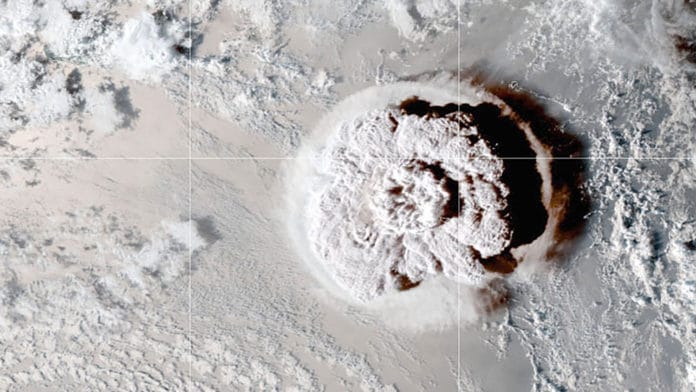Hunga Tonga–Hunga Ha’apai is a submarine volcano in the South Pacific ocean. On 20 December 2021, an eruption began on Hunga Tonga–Hunga Ha’apai. About four weeks later, on 15 January 2022, the eruption reached a very large and powerful climax. A new study has confirmed that the eruption of the Hunga Tonga-Hunga Ha’apai submarine volcano was one of the most explosive volcanic events of the modern era.
For this study, scientists combined extensive satellite data with ground-level observations to show that the eruption was unique in observed science in both its magnitude and speed. It was also unique in the range of the fast-moving gravity and atmospheric waves it created.
During the eruption, it produces a vertical plume that extends more than 50km (30 miles) above the earth’s surface. For the following 12 hours, the planet’s largest source of gravity waves was the heat generated by hot ash and water in the plume. The eruption also created gravitational waves resembling ripples, and satellite measurements revealed that they spread throughout the Pacific basin.
In addition, the explosion caused waves in our atmosphere that reverberated around the planet at least six times and accelerated to the fastest speeds ever recorded in our atmosphere, which is 320 meters per second, or 720 miles per hour.
The authors of the research state that this is the first time in the observational record where a single event dominated such a vast area and that it will assist scientists in developing future atmospheric weather and climate models.
Dr. Corwin Wright, a Royal Society University Research Fellow, based at the Centre for Space, Atmospheric and Oceanic Science at the University of Bath, is the paper’s lead author. He said: “This was a genuinely huge explosion, and truly unique in terms of what science has observed to date. We’ve never seen atmospheric waves going around the world or at this speed – they were traveling very close to the theoretical limit.”
“The eruption was an amazing natural experiment. The data we’ve gathered on it will enhance our understanding of our atmosphere and help us improve our weather and climate models.”
Co-author Dr. Scott Osprey from the National Centre for Atmospheric Science, based within the Department of Physics, University of Oxford, expects to see further impacts from the Hunga Tonga eruption: “Our study nicely shows how the striking display of global waves is driven by the huge amounts of seawater vaporized during the eruption. However, my gut feeling is that there is more to come from this eruption. As the exceptional amount of water vapor spreads throughout the stratosphere, eyes will turn to the Antarctic ozone hole and just how severe it will be in the spring.”
Journal Reference:
- Wright, C.J., Hindley, N.P., Alexander, M.J. et al. Surface-to-space atmospheric waves from Hunga Tonga-Hunga Ha’apai eruption. Nature (2022). DOI: 10.1038/s41586-022-05012-5
